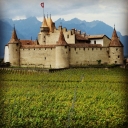Last visited in May 2015
Set on a 30 km stretch of the south facing coast of Lake Geneva between Lausanne and Montreux in the canton of Vaud, these beautiful vineyards have been described by Forbes as “the Best Wine Region You’ve Never Heard of“. The region is comprised of 8 wine-making villages on Lake Geneva and the setting of Lavaux is beautiful any time of the year. You can hike here any time from March to November, according to Switzerland Tourism, but if you want to come both see Lavaux and sample the wines, there is one perfect time to do it – the weekend of Caves Ouvertes Vaudoises (Open Cellars) in May.
I blundered my way into discovering this. My best friend lives in Lausanne and I was visiting him for a few days. Our plan for one Saturday morning was to just take the train to Lutry and do a small hike around the vineyards. The local train was extremely crowded for a Saturday, and as we got off at the station, we noticed that most of our fellow passengers were getting off too, then lining up at a nearby office. After growing up in the USSR, curiosity about queues is in my blood, so we just had to check out what was going on. That’s how we discovered Caves Ouvertes or Open Cellars. Keep in mind that Caves Ouvertes is not limited to Lavaux, but takes place all over the Canton of Vaud, and you can explore wineries outside Lavaux. Geneva, Valais, Neuchatel and the German-speaking Cantons all have similar events in spring, so you can find out more by doing a search here.
This is how it works. You buy a ticket, which includes a glass and a list of participating wineries and access to free shuttle between the different vineries both in Lavaux and elsewhere in the canton, should you opt to take it. The glass can then be used at the participating wineries to sample as much of their product as you want. At a price of 15 Swiss francs per person, I honestly think this was the best deal I ever found in Switzerland. We opted out of taking the shuttle and just proceeded to do our walk as planned, stopping along the way to sample wine and have a bite to eat. Some of the wineries offer traditional Swiss fare, like raclette, and although the food is not included in your ticket, it is also very reasonably priced. The local wines are also considered to be an ideal pairing for raclette or fondue. According to local tradition, if you pair your food with the wrong drink e.g. water or soda, the cheese can harden in your stomach, causing indigestion. I did not put that one to the test.
There is evidence of vineyards in Lavaux going back to the Romans, but it’s the Benedictine and Cistercian monasteries, that controlled the area in the 11th century that are credited for developing this industry here. What makes this great wine country is the so-called triple effect of the sun – the natural sunlight and heat, the reflected sunlight from the surface of the lake, and the warmth stored in the walls of the vineyard terraces. Most of the wine made here comes from the Chasselas grape, a distinctive white, dry and fruity. Red wines (e.g. merlots) are also produced in the area, but to my taste they are nowhere near as good as the whites.
If you can’t make Caves Ouvertes, a wine tasting can be arranged through the Lavaux Vinorama in Lavaz, which is open most of the year. A good option for a walk around the area is to do the popular St Saphorin-Lutry route which is a little under 12 km and not very difficult, but there are other hiking options you can explore here. If you don’t want to walk there are two tourist train options in season – the Lavaux Express and Lavaux Panoramic trains.
Another completely different way to experience Lavaux is to see it from Lake Geneva aboard a historic Belle Epoque paddleboat. One option is to board the boat at Lausanne-Ouchy and sail to Montreux or Chillon Castle, which will give you a great opportunity to see the both the lake and the vineyards of Lavaux. You can find more information on the boats here.
Keep in mind that the Lavaux region is just a small part of the wine-making tradition in Vaud. To learn more about the wines in the canton consider visiting the wine museum in Aigle’s spectacular chateau. Another scenic option is the town of Vufflens-le-Chateau, located between Lausanne and Geneva and home to another beautiful castle, unfortunately is not open to the public, but still worth a stop.


